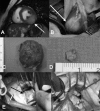Twenty years experience in oncologic surgery for primary cardiac tumors
- PMID: 23660160
- PMCID: PMC3915578
Twenty years experience in oncologic surgery for primary cardiac tumors
Abstract
Introduction: Primary cardiac tumors are uncommon in cardiac surgery. To investigate the clinical presentation, surgical results and long-term follow-up we retrospectively analyzed our experience in the treatment of primary cardiac tumors.
Patients and methods: Ninety-one patients with primary cardiac tumors underwent surgery in our department in the last 20 years. Fifty-one patients were female, the mean age was 62,2 years. Sixty-three had myxomas, 22 had papillary fibroelastoma, 4 had malignant neoformations and 2 had other benign tumors.
Results: All myxomas, fibroelastomas and angiomyolipoma were radically removed. Only a palliative treatment was possible in malignant disease. In-hospital mortality was 1.2%. The mean follow-up time was 78.5 months. Three patients had recurrence of myxoma, all patients with malignant disease dead during the follow-up.
Discussion: Primary benign cardiac tumors can be treated with low morbidity and mortality. The follow-up demonstrates that radical surgery is curative in case of benign tumors. The prognosis of malignant tumors is still poor. Palliative procedures have small impact on survival in these patients.
Figures


References
-
- Kun Y, Yinglong L, Hongyue W, et al. Epidemiological and pathological characteristics of cardiac tumors: a clinical study of 242 cases. Interact Cardiovasc Thorac Surg. 2007;6:636–639. - PubMed
-
- Basso C, Valente M, Poletti A, et al. Surgical pathology of primary cardiac and pericardial tumors. Eur J Cardiothorac Surg. 1997;12:730–737. - PubMed
-
- Columbus MR. De Re Anatomica, Liber XV. p. 269. Venice, N Bevilacque: 1559.
-
- Yater WM. Tumors of the heart and pericardium: pathology, symptomatology, and report of nine cases. Arch Intern Med. 1931;48:267.
-
- Barnes AR, Beaver DC, Snell AMP. Primary sarcoma of the heart:report of a case with eletrocardiographic and pathological studies. Am Heart J. 1934;9:480.
MeSH terms
LinkOut - more resources
Full Text Sources
Medical
